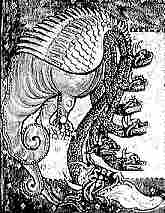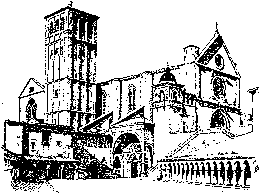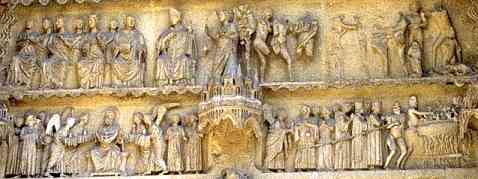 |
|
Religious
Experience |
|
Medieval
Christianity was a religion of authority, and that authority was based
and confirmed in written texts. The literature of the medieval church
tends to be cumulative. The Bible
and the patristic
literature formed a basis for commentary, development of concepts and
debate. Many facets of church belief and practice which we may believe
were founded in the very roots of the religion were developed in the medieval
era, but they were constructed by a continual process of building on and
refining of earlier work. There was, however, some space for works based
on mystical experience and personal divine revelation. This could be a
risky area. The church was always alert to the danger of heresy. |
 |
Within
the New Testament
of the Bible the book of The Revelation of St John stands
out as a piece of experiential writing, full of wild imagery, at the end
of a long series of narratives and moral counselling. The images were
reproduced in volumes of the Apocalypse,
but were also turned to moral instructional purpose in representations
of the Last Judgment in sculpture and wall painting. These latter emphasised
the fate of the souls of the good and wicked rather than the strange creatures
and mighty battles that populate the text. The Book of Revelation
was tamed and rendered didactic for public consumption. |
|
Image
from a 13th century French Apocalypse (Cambridge, Trinity College Library,
MS R 16.2, f.14). |
|
|
The
Last Judgment on a tympanum at Rheims Cathedral, showing the fates of
souls. |
|
The
term mysticism is used for processes of unification with God and direct
revelation of God's power and love. Much debate in the medieval church
revolved around the nature and possibility of such revelation, and its
relationship with intellect and reason. This is really intellectual debate
about the philosophy of mysticism, rather than actual experiential writing.
A very early treatise by Pseudo-Dionysius the Areopagite, probably a Syrian
monk of the late 5th or 6th centuries, fuelled this debate for centuries
and various translations from Greek into Latin were made of his work during
the course of the middle ages. As an aside, the reason he has a name that
sounds as if it comes from a Monty Python sketch is that for centuries
he was believed to be an individual converted to Christianity by St Paul,
and he even included some fraudulent references to witnessing events of
that time to confound the issue. Funny thing for a mystical philosopher
to do. |
|
| |
Pseudo-Dionysius
codified the concept of the nine orders of angels, much used in medieval
art, as in this stained glass window in All Saints, North Street, York. |
 |
There
were those who claimed experience of divine revelation, but they did not
all write treatises on the subject. St Francis of Assisi received the
stigmata, or wounds, of Christ. Modern psychologists would no doubt have
a bit to say about that, and the medieval church found Francis a bit of
a problem at times. Once he had safely expired they could make him a saint
and build a nice big church with lovely frescos in his honour. He did
not leave any autobiographical text of his personal religious experience. |
|
The
church of St Francis in Assisi. |
|
Recording
personal religious experiences required ratification by the church. In
the early 12th century a young and sickly Hildegard of Bingen started
receiving prophetic visions with startling imagery. At around the age
of 40, when she had achieved the status of superior of a Benedictine convent,
she became convinced that these were divine revelations which should be
recorded and publicised. Hildegard could not write. The abbot who supervised
her community ordered a monk to write down her descriptions, but the work
had to be examined by the bishop and clergy of Mainz, the bishop of Verdun
and Pope Eugene II before it could be accepted as the divinely revealed
word of God. Her major work, called Scivias,
was printed in Paris in 1513, by then an acceptable work of religious
writing. Hildegard is still known today, but mainly for her church music
which continues to be recorded. Medical experts who have examined descriptions
of her revelations in detail are convinced that she suffered from serious
migraines, but God reveals himself in mysterious ways.
|
|
continued |
 Categories
of Works Categories
of Works |
|
 |
 |
 |
 |
 |



